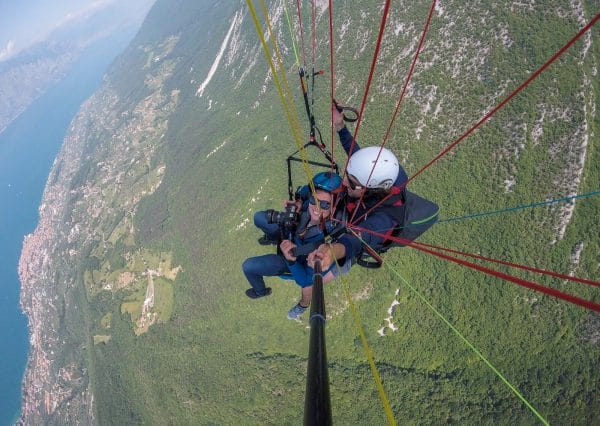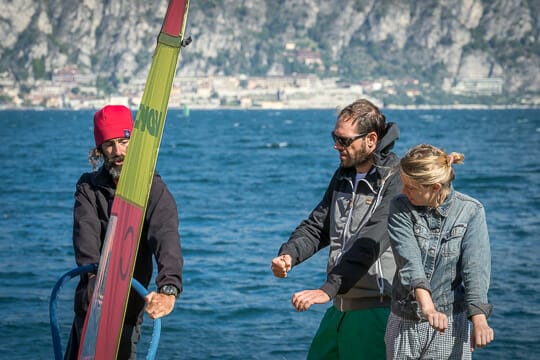We talk about sport, Nature, Mindfulness and well-being with Paolo Ruffini
Angela Trawoeger and Paola Ruffini
Doing sport in a natural environment is discovery and exploration. If you have been reading us for a while, you already know that every moment spent by us in the woods, in front of a mountain view or surfing in the middle of the lake is an opportunity to know ourselves better and feel more alive.
We do sport to let off steam, to unwind, to re-energise ourselves and to relax. However, at a certain point our concept of time and our thoughts stop and we feel completely free and totally in the moment. Is this meditation? Does it happen because we are at one with Nature?
A few months ago, I had the pleasure of meeting Paola, a yoga teacher and Buteyko Method instructor, who loves Nature as we do. Paola has lived and studied in Germany for 8 years, trying different styles of Yoga from Static Meditative to Dynamic and Sporty: she specialised in Vinyasa Yoga which is characterised by fluid movement coordinated to breathing. Since 2021, she has been living and teaching yoga in Malcesine on Lake Garda.
I interviewed her about yoga and meditation, to understand better the ties between Humans and Nature found in sport and the discipline that she teaches.
Hello Paola, can the state of lack of thoughts that you experience during sport be considered the same as meditation?
I’d say yes. This state that you mention reminds me of the second verse of the Yogasutra in which Patanjali, the father of yoga, describes how to control the oscillations of our minds.
We are often overstimulated by our minds being in constant activity. We ask ourselves, for example, how to behave to a friend, how to resolve a problem or even what to make for supper. This continual flow of thoughts doesn’t allow ourselves to live the moment in an understanding way.
When our minds are active, we identify with our thoughts but we aren’t our thoughts and yoga can help us to overcome this identification. With a quiet mind we can experiment with peace and well-being.
Living in the here and now changes our experience and approach to Nature and therefore how we do sport. While we walk in the woods, for example, we can think about the performance of that sport and the reason for doing it, or I can enjoy the journey observing the colours and shapes of the wood or listening to its sounds. This is how you can slowly learn to slow down and really feel that you are a living part of Nature.

What is Yoga?
The word Yoga comes from Sanskrit and literally means Union but also Unity and Uniqueness. In spiritual terms this means the union of individual consciousness with universal.
We are talking about a long, deep journey which Patanjali summarises in 8 points: Ethical and Moral principles towards ourselves and others (Yama and Niyama), physical positions (Asana), breath and energy control (Pranayama), control of our senses (Pratyahara), concentration (Dharana), meditation (Dhyana) and lastly spiritual enlightenment (Samadhi).
In the Yoga that we do in the West, the most practised of these 8 points are particularly Asana, Pranayama and Dhyana. Many come to yoga fascinated by the physical positions and then, by practising these, discover so much more.
Yoga is a discipline that never stops teaching you something. It helps to know yourself better, overcome one’s limits and to let go of whatever you no longer need. It brings back in to balance our excesses, gives harmony and well-being

Is there a bond between yoga and Nature?
There certainly is. The Philosophy of Yoga asks for respect, inclusion and thanks to Mother Nature.
Distancing ourselves from Nature is damaging to humans and the regular practise of yoga helps us to understand that we are part of Nature and that in this special moment we have a need to reconnect with her. In fact, we need to remember that the world doesn’t rotate around us.
The bond with Nature is present also on a physical lever: in the Asana, we find Roots, Balance, Stability and Lightness. For example, we think about the stability of the position called the Mountain and the connection between stable roots and the thrust towards the sky in the position called the Tree.
What are the Asanas and why are they important?
The Asanas are positions of your body assumed during yoga. Every Asana works on a physical and mental level: some positions give us energy and others help us to relax. Others still help us to maintain concentration and find stability, force and balance.

The Arching positions, for example, help with posture and have an immediate effect on our mood giving lots of vitality. The Folding forwards positions lengthen the spinal cord and are fantastic in the evening or if you need to relax during the day.
Let’s talk a bit about Meditation.
Let’s undo the myth that you have to sit cross legged with your eyes closed, completely still for hours even getting wet if it rains.
Meditation is for everyone, it’s enough to find a stable and comfortable position (even sitting on a chair) and connecting to the present. There are different ways to pause your thoughts and stop projecting yourself into the past and future: you can listen to your breathing or visualise something, you can recite a mantra or follow a guided meditation.
It’s enough to do this for a few minutes every day to feel the first benefits; meditation improves your powers of concentration, your memory, helps you to free your mind and get in touch with your deepest self.
Through meditation, your mind becomes calmer and more silent and you reach a level of peace that, with a bit of practise, we can achieve all day.
What is the role of breathing in yoga?
It’s fundamental. Nowadays, most adults breathe badly without realising it. I welcome the advent of a healthier style of life with attention to movement and diet but little attention is paid to breathing. And this is with the knowledge that we can only live for a few minutes without breathing.
Yoga breathing is extended, slow, regular and efficient.
As well as acting on your emotional state and calming your thoughts, good breathing helps good digestion, your heart and the correct working of the diaphragm: inhaling and exhaling correctly, your body tissues receive more oxygen and get rid of more carbon dioxide, your muscles become more flexible and sports activities get easier resulting in less panting.
In my yoga lessons I also use Buteyko method exercises to retrain your breathing and to keep a correct balance of oxygen and carbon dioxide in the blood flow. These exercises are really useful for anyone suffering from asthma or other respiratory diseases such as those connected with long covid.
Doing yoga and meditation, therefore, can help your sports abilities?
Absolutely. Yoga helps your strength, balance, flexibility, agility and resistance and when you add yoga to your sports training you will see great benefits. Also, yoga teaches you to feel the movement of your body in space and this sensory awareness will help your sports movement.
How do I start doing yoga and what should I watch out for?
My advice is to start with an expert who knows how to guide you, encourage you and help you. A good yoga teacher won’t discourage you with Asanas that are too complicated and, at the same time, they will show you how to do the positions without hurting yourself, respecting your body, leading you gently and always trying to widen your comfort zone.
Yoga lessons don’t involve comparisons or competitions – your attention is always on your personal journey.







